#conquest of tomatoes
Text

#196#r/196#gardening#communism#kraz mazov#karl marx#kropotkin#conquest of tomatoes#conquest of bread#socialism#anarchism#anarcho-goblinism#anarcho-imgonnaeatyourfuckingvegetablesism#YUM!
837 notes
·
View notes
Note
I'll help and manifest with you
🕯️🕯️🕯️I summon thee 💘🕯️🕯️🕯️🕯️
🕯️🕯️🕯️Manifesting a 💘anon 🕯️🕯️🕯️
- 🍰nom
thank you for your help, now I hope that 💘anon will appear.
#Heartbeat conquest#webtoon#the tomato can#I love you 💘-non#Heartbeat Conquest#Diana#Sezar#Bambi#Cassian von Alexia#heartbeat conquest#heartbeat conquest x reader
1 note
·
View note
Text

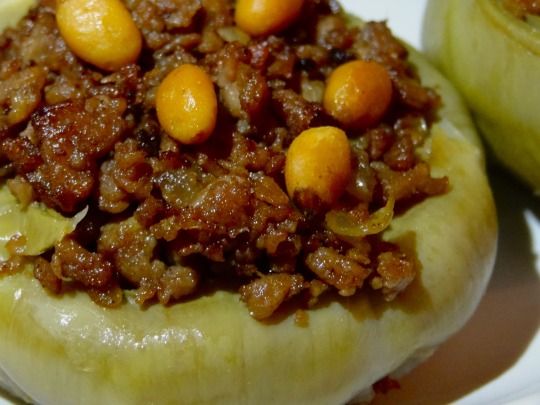
[ID: The first image is of four stuffed artichoke hearts on a plate with a mound of rice and fried vermicelli; the second is a close-up on one artichoke, showing fried ground 'beef' and golden pine nuts. End ID]
أرضي شوكي باللحم / Ardiyy-shawkiyy b-al-lahm (Stuffed artichoke hearts)
Artichoke hearts stuffed with spiced meat make a common dish throughout West Asia and North Africa, with variations on the recipe eaten in Lebanon, Syria, Palestine, Algeria, and Morocco. In Palestine, the dish is usually served on special occasions, either as an appetizer, or as a main course alongside rice. The artichokes are sometimes paired with cored potatoes, which are stuffed and cooked in the same manner. Stuffed artichokes do not appear in Medieval Arab cookbooks (though artichokes do), but the dish's distribution indicates that its origin may be Ottoman-era, as many other maḥshis (stuffed dishes) are.
The creation of this dish is easy enough once the artichoke hearts have been excavated (or, as the case may be, purchased frozen and thawed): they are briefly deep-fried, stuffed with ground meat and perhaps pine nuts, then stewed in water, or water and tomato purée, or stock, until incredibly tender.
While simple, the dish is flavorful and well-rounded. A squeeze of lemon complements the bright, subtle earthiness of the artichoke and cuts through the richness of the meat; the fried pine nuts provide a play of textures, and pick up on the slight nutty taste that artichokes are known for.
Terminology and etymology
Artichokes prepared in this way may be called "ardiyy-shawkiyy b-al-lahm." "Ardiyy-shawkiyy" of course means "artichoke"; "ب" ("b") means "with"; "ال" ("al") is the determiner "the"; and "لَحْم" ("laḥm") is "meat" (via a process of semantic narrowing from Proto-Semitic *laḥm, "food"). Other Palestinian Arabic names for the same dish include "أرضي شوكي محشي" ("ardiyy-shawkiyy maḥshi," "stuffed artichokes"), and "أرضي شوكي على ادامه" ("ardiyy-shawkiyy 'ala adama," "artichokes cooked in their own juice").
The etymology of the Levantine dialectical phrase meaning "artichoke" is interestingly circular. The English "artichoke" is itself ultimately from Arabic "الخُرْشُوف" ("al-khurshūf"); it was borrowed into Spanish (as "alcarchofa") during the Islamic conquest of the Iberian peninsula, and thence into English via the northern Italian "articiocco." The English form was probably influenced by the word "choke" via a process of phono-semantic matching—a type of borrowing wherein native words are found that sound similar to the foreign word ("phonetics"), and communicate qualities associated with the object ("semantics").
"Artichoke" then returned to Levantine Arabic, undergoing another process of phono-semantic matching to become "ardiyy-shawkiyy": أَرْضِيّ ("ʔarḍiyy") "earthly," from أَرْض ("ʔarḍ"), "Earth, land"; and شَوْكِيّ ("shawkiyy") "prickly," from شَوْك ("shawk"), "thorn."
Artichokes in Palestine
Artichoke is considered to be very healthful by Palestinian cooks, and it is recommended to also consume the water it is boiled in (which becomes delightfully savory and earthy, suitable as a broth for soup). In addition to being stuffed, the hearts may be chopped and cooked with meat or potatoes into a rich soup. These soups are enjoyed especially during Ramadan, when hot soup is popular regardless of the season—but the best season for artichokes in the Levant is definitively spring. Stuffed artichokes are thus often served by Jewish people in North Africa and West Asia during Passover.
Artichokes grow wild in Palestine, sometimes in fields adjacent to cultivated crops such as cereals and olives. Swiss traveler Johann Ludwig Burckhardt, writing in 1822, referred to the abundant wild artichoke plants (presumably Cynara syriaca) near لُوبْيا ("lūbyā"), a large village of stone buildings on a hilly landscape just west of طبريا ("ṭabariyya," Tiberias):
About half an hour to the N. E. [of Kefer Sebt (كفر سبط)] is the spring Ain Dhamy (عين ظامي), in a deep valley, from hence a wide plain extends to the foot of Djebel Tor; in crossing it, we saw on our right, about three quarters of an hour from the road, the village Louby (لوبي), and a little further on, the village Shedjare (شجره). The plain was covered with the wild artichoke, called khob (خُب); it bears a thorny violet coloured flower, in the shape of an artichoke, upon a stem five feet in height.
(Despite resistance from local militia and the Arab Liberation Army, Zionist military groups ethnically cleansed Lubya of its nearly 3,000 Palestinian Arab inhabitants in July of 1948, before reducing its buildings and wells to rubble, The Jewish National Fund later planted the Lavi pine forest over the ruins.)
Artichokes are also cultivated and marketed. Elihu Grant, nearly a century after Burckhardt's writing, noted that Palestinian villages with sufficient irrigation "[went] into gardening extensively," and marketed their goods in crop-poor villages or in city markets:
Squash, pumpkin, cabbage, cauliflower, lettuce, turnip, beet, parsnip, bean, pea, chick-pea, onion, garlic, leek, radish, mallow and eggplant are common varieties [of vegetable]. The buds of the artichoke when boiled make a delicious dish. Potatoes are getting to be quite common now. Most of them are still imported, but probably more and more success will be met in raising a native crop.
Either wild artichokes (C. syriaca) or cardoons (C. cardunculus, later domesticated to yield modern commerical artichokes) were being harvested and eaten by Jewish Palestinians in the 1st to the 3rd centuries AD (the Meshnaic Hebrew is "עַכָּבִיּוֹת", sg. "עַכָּבִית", "'aqubit"; related to the Arabic "عَكُوب" "'akūb," which refers to a different plant). The Tosefta Shebiit discusses how farmers should treat the sprouting of artichokes ("קינרסי," "qinrasi") during the shmita year (when fields are allowed to lie fallow), indicating that Jews were also cultivating artichokes at this time.
Though artichokes were persistently associated with wealth and the feast table (perhaps, Susan Weingarten speculates, because of the time they took to prepare), trimming cardoons and artichokes during festivals, when other work was prohibited, was within the reach of common Jewish people. Those in the "upper echelons of Palestinian Jewish society," on the other hand, had access to artichokes year-round, including (through expensive marvels of preservation and transport) when they were out of season.
Jewish life and cuisine
Claudia Roden writes that stuffed artichoke, which she refers to as "Kharshouf Mahshi" (خرشوف محشي), is "famous as one of the grand old Jerusalem dishes" among Palestinian Jews. According to her, the stuffed artichokes used to be dipped in egg and then bread crumbs and deep-fried. This breading and frying is still referenced, though eschewed, in modern Sephardi recipes.
Prior to the beginning of the first Aliyah (עלייה, wave of immigration) in 1881, an estimated 3% of the overall population of Palestine, or 15,011 people, were Jewish. This Jewish presence was not the result of political Zionist settler-colonialism of the kind facilitated by Britain and Zionist organizations; rather, it consisted of ancestrally Palestinian Jewish groups, and of refugees and religious immigrants who had been naturalized over the preceding decades or centuries.
One such Jewish community were the Arabic-speaking Jews whom the Sephardim later came to call "מוּסְתערבים" or "مستعربين" ("Musta'ravim" or "Musta'ribīn"; from the Arabic "مُسْتَعْرِب" "musta'rib," "Arabized"), because they seemed indifferentiable from their Muslim neighbors. A small number of them were descendants of Jews from Galilee, which had had a significant Jewish population in the mid-1st century BC; others were "מגרבים" ("Maghrebim"), or "مغربية" ("Mughariba"): descendents of Jews from Northwest Africa.
Another major Jewish community in pre-mandate Palestine were Ladino-speaking descendents of Sephardi Jews, who had migrated to Palestine in the decades following their expulsion from Spain and then Portugal in the late 15th century. Though initially seen as foreign by the 'indigenous' Mista'avim, this community became dominant in terms of population and political influence, coming to define themselves as Ottoman subjects and as the representatives of Jews in Palestine.
A third, Yiddish- and German-speaking, Askenazi Jewish population also existed in Palestine, the result of immigration over the preceding centuries (including a large wave in 1700).
These various groups of Jewish Palestinians lived as neighbors in urban centers, differentiating themselves from each other partly by the language they spoke and partly by their dress (though Sephardim and Ashkenazim quickly learned Arabic, and many Askenazim and Muslims learned Ladino). Ashkenazi women also learned from Sephardim how to prepare their dishes. These groups' interfamiliarity with each other's cuisine is further evidenced by the fact that Arabic words for Palestinian dishes entered Ladino and Yiddish (e.g. "كُفْتَة" / "kufta," rissole; "مَزَّة" "mazza," appetizer); and words entered Arabic from Ladino (e.g. "דונסי" "donsi," sweet jams and fruit leather; "בוריק" "burek," meat and cheese pastries; "המים" "hamim," from "haminados," braised eggs) and Yiddish (e.g. "לעקעך" "lakach," honey cake).
In addition to these 'native' Jews were another two waves of Ashkenazi migration in the late 18th and early-to-mid 19th centuries (sometimes called the "היישוב הישן," "ha-yishuv ha-yashan," "old settlement," though the term is often used more broadly); and throughout the previous centuries there had also been a steady trickle of religious immigration, including elderly immigrants who wished to die in Jerusalem in order to be present at the appointed place on the day of Resurrection. Recent elderly women immigrants unable to receive help from charitable institutions would rely on the community for support, in exchange helping the young married women of the neighborhood with childcare and with the shaping of pastries ("מיני מאפה").
In the first few centuries AD, the Jewish population of Palestine were largely farmers and agricultural workers in rural areas. By the 16th century, however, most of the Jewish population resided in the Jewish Holy Cities of Jerusalem (القُدس / al-quds), Hebron (الخليل / al-khalil), Safed (صفد), and Tiberias (طبريا / ṭabariyya). In the 19th century, the Jewish population lived entirely in these four cities and in expanding urban centers Jaffa and Haifa, alongside Muslims and Christians. Jerusalem in particular was majority Jewish by 1880.
In the 19th century, Jewish women in Jerusalem, like their Christian and Muslim neighbors, used communal ovens to bake the bread, cakes, matzah, cholent, and challah which they prepared at home. One woman recalls that bread would be sent to the baker on Mondays and Thursdays—but bribes could be offered in exchange for fresh bread on Shabbat. Charges would be by the item, or else a fixed monthly payment.
Trips to the ovens became social events, as women of various ages—while watching the bakers, who might not put a dish in or take it out in time—sent up a "clatter" of talking. During religious feast days, with women busy in the kitchen, some families might send young boys in their stead.
Markets and bakeries in Jerusalem sold bread of different 'grades' based on the proportion of white and wheat flour they contained; as well as flatbread (خبز مفرود / חובז מפרוד / khobbiz mafroud), Moroccan מאווי' / ماوي / meloui, and semolina breads (כומאש / كماج / kmaj) which Maghrebim especially purchased for the Sabbath.
On the Sabbath, those who had brick ovens in their sculleries would keep food, and water for tea and coffee, warm from the day before (since religious law prohibits performing work, including lighting fires, on Shabbat); those who did not would bring their food to the oven of a neighbor who did.
Palestinian Jewish men worked in a variety of professions: they were goldsmiths, writers, doctors, merchants, scientists, linguists, carpenters, and religious scholars. Jewish women, ignoring prohibitions, engaged in business, bringing baked goods and extra dairy to markets in Jerusalem, grinding and selling flour, spinning yarn, and making clothing (usually from materials purchased from Muslims); they were also shopkeepers and sellers of souvenirs and wine. Muslims, Jews, and Christians shared residential courtyards, pastimes, commercial enterprises, and even holidays and other religious practices.
Zionism and Jewish Palestinians
Eastern European Zionists in the 1880s and 90s were ambivalent towards existing Jewish communities in Palestine, often viewing them as overly traditional and religious, backwards-thinking, and lacking initiative. Jewish Palestinians did not seem to conform with the land-based, agricultural, and productivist ideals of political Zionist thinkers; they were integrated into the Palestinian economy (rather than seeking to create their own, segregated one); they were not working to create a Jewish ethnostate in Palestine, and seemed largely uninterested in nationalist concerns. Thus they were identified with Diaspora Jewish culture, which was seen as a remnant of exile and oppression to be eschewed, reformed, or overthrown.
These attitudes were applied especially to Sephardim and Mista'arevim, who were frequently denigrated in early Zionist literature. In 1926, Revisionist Zionist leader Vladimir Jabotinsky wrote that the "Jews, thank God, have nothing in common with the East. We must put an end to any trace of the Oriental spirit in the Jews of Palestine." The governance of Jewish communities was, indeed, changed with the advent of the British Mandate (colonial rule which allowed the British to facilitate political Zionist settling), as European political and "socialist" Zionists promoted Ashkenazi over Sephardi leadership.
Under the Ottomans, the millet system had allowed a degree of Jewish and Christian autonomy in matters of religious study and leadership, cultural and legal affairs, and the minting of currency. The religious authority of all Jewish people in Palestine had been the Sephardi Rabbi of Jerusalem, and his authority on matters of Jewish law (like the authority of the Armenian Patriarchate on matters of Christian law) extended outside of Palestine.
But British and European funding allowed newer waves of Ashkenazi settlers (sometimes called "היישוב החדש," "ha-yishuv ha-khadash," "new settlement")—who, at least if they were to live out the ideals of their sponsors, were more secular and nationalist-minded than the prior waves of Ashkenazi immigration—to be de facto independent of Sephardi governance. Several factors lead to the drying up of halaka (donated funds intended to be used for communal works and the support of the poor in Sephardi communities), which harmed Sephardim economically.
Zionist ideas continued to dominate newly formed committees and programs, and Palestinian and Sephardi Jews reported experiences of racial discrimination, including job discrimination, leading to widespread poverty. The "Hebrew labor" movement, which promoted a boycott of Palestinian labor and produce, in fact marginalized all workers racialized as Arab, and promises of work in Jewish labor unions were divided in favor of Ashkenazim to the detriment of Sephardim and Mizrahim. This economic marginalization coincided with the "social elimination of shared indigenous [Palestinian] life" in the Zionist approach to indigenous Jews and Muslims.
Despite the adversarial, disdainful, and sometimes abusive relationship which the European Zionist movement had with "Oriental" Jews, their presence is frequently used in Zionist food and travel writing to present Israel as a multicultural and pluralist state. Dishes such as stuffed artichokes are claimed as "Israeli"—though they were eaten by Jews in Palestine prior to the existence of the modern state of Israel, and though Sephardi and Mizrahi diets were once the target of a civilizing, correcting mission by Zionist nutritionists. The deep-frying that stuffed artichokes call for brings to mind European Zionists' half-fascinated, half-disgusted attitudes towards falafel.
The point is not to claim a dish for any one national or ethnic group—which is, more often than not, an exercise in futility and even absurdity—but to pay attention to how the rhetoric of food writing can obscure political realities and promote the colonizer's version of history. The sinking of Jewish Palestinian life prior to the advent of modern political Zionism, and the corresponding insistence that it was Israel that brought "Jewish cuisine" to Palestine, allow for such false dichotomies as "Jewish-Palestinian relations" or "Jewish-Arab relations"; these descriptors further Zionist rhetoric by making a clear situation of ethnic cleansing and settler-colonialism sound like a complex and delicate issue of inter-ethnic conflict. To boot, the presentation of these communities as having merely paved the way to Zionist nationalism ignores their existence as groups with their own political, social, and cultural lives and histories.
Help evacuate a Gazan family with Operation Olive Branch
Buy an eSim for use in Gaza
Help Anera provide food in Gaza
Ingredients:
Serves 4 (as a main dish).
For the artichokes:
6 fresh, very large artichokes; or frozen (not canned) whole artichoke hearts
1 lemon, quartered (if using fresh artichokes)
250g (1 1/2 cups) vegetarian ground beef substitute; or 3/4 cup TVP hydrated with 3/4 cup vegetarian 'beef' stock from concentrate
1 yellow onion, minced
Scant 1/2 tsp kosher salt
1/2 tsp ground black pepper
1 pinch ground cardamom (optional)
1/4 tsp ground allspice or seb'a baharat (optional)
1 Tbsp pine nuts (optional)
Water, to simmer
Oil, to fry
2 tsp vegetarian 'beef' stock concentrate, to simmer (optional)
Lemon, to serve
Larger artichokes are best, to yield hearts 3-4 inches in width once all leaves are removed. If you only have access to smaller artichokes, you may need to use 10-12 to use up all the filling; you might also consider leaving some of the edible internal leaves on.
The meat may be spiced to taste. Sometimes only salt and black pepper are used; some Palestinian cooks prefer to include seb'a baharat, white pepper, allspice, nutmeg, cardamom, and/or cinnamon.
Medieval Arab cookbooks sometimes call for vegetables to be deep-fried in olive oil (see Fiḍālat al-Khiwān fī Ṭayyibāt al-Ṭaʿām wa-l-Alwān, chapter 6, recipe no. 373, which instructs the reader to treat artichoke hearts this way). You may use olive oil, or a neutral oil such as canola or sunflower (as is more commonly done in Palestine today).
Elihu Grant noted in 1921 that lemon juice was often served with stuffed vegetable dishes; today stuffed artichokes are sometimes served with lemon.
For the rice:
200g Egyptian rice (or substitute any medium-grained white rice)
2 tsp broken semolina vermicelli (شعيريه) (optional)
1 tsp olive oil (optional)
Large pinch salt
520g water, or as needed
Broken semolina vermicelli (not rice vermicelli!) can be found in plastic bags at halal grocery stores.
Instructions:
For the stuffed artichokes:
1. Prepare the artichoke hearts. Cut off about 2/3 of the top of the artichoke (I find that leaving at least some of the stem on for now makes it easier to hollow out the base of the artichoke heart without puncturing it).
2. Pull or cut away the tough outer bracts ("leaves") of the artichoke until you get to the tender inner leaves, which will appear light yellow all the way through. As you work, rub a lemon quarter over the sides of the artichoke to prevent browning.
3. If you see a sharp indentation an inch or so above the base of the artichoke, use kitchen shears or a sharp knife to trim off the leaves above it and form the desired bowl shape. Set aside trimmings for a soup or stew.
4. Use a small spoon to remove the purple leaves and fibers from the center of the artichoke. Make sure to scrape the spoon all along the bottom and sides of the artichoke and get all of the fibrous material out.
5. Use a paring knife to remove any remaining tough bases of removed bracts and smooth out the base of the artichoke heart. Cut off the entire stem, so that the heart can sit flat, like a bowl.
6. Place the prepared artichoke heart in a large bowl of water with some lemon juice squeezed into it. Repeat with each artichoke.
7. Drain artichoke hearts and pat dry. Heat a few inches of oil in a pot or wok on medium and fry artichoke hearts, turning over occasionally, for a couple minutes until lightly browned. If you don't want to deep-fry, you can pan-fry in 1 cm or so of oil, flipping once. Remove with a slotted spoon and drain.
8. Prepare the filling. Heat 1 tsp of olive oil in a large skillet on medium-high and fry onions, agitating often, until translucent.
Tip: Some people add the pine nuts and brown them at this point, to save a step later. If you do this, they will of course be mixed throughout the filling rather than being a garnish on top.
9. Add spices, salt, and meat substitute and fry, stirring occasionally, until meat is browned. (If using TVP, brown it by allowing it to sit in a single layer undisturbed for 3-4 minutes, then stir and repeat.) Taste and adjust spices and salt.
10. Heat 1 Tbsp of olive oil or margarine in a small pan on medium-low. Add pine nuts and fry, stirring constantly, until they are a light golden brown, then remove with a slotted spoon. Note that, once they start taking on color, they will brown very quickly and must be carefully watched. They will continue to darken after they are removed from the oil, so remove them when they are a shade lighter than desired.
11. Stuff the artichoke hearts. Fill the bowl of each heart with meat filling, pressing into the bottom and sides to fill completely. Top with fried pine nuts.
12. Cook the artichoke hearts. Place the stuffed artichoke hearts in a single layer at the bottom of a large stock pot, along with any extra filling (or save extra filling to stuff peppers, eggplant, zucchini, or grape leaves).
13. Whisk stock concentrate into several cups of just-boiled water, if using—if not, whisk in about a half teaspoon of salt. Pour hot salted water or stock into the pot to cover just the bottoms of the stuffed artichokes.
14. Simmer, covered, for 15-20 minutes, until the artichokes are tender. Simmer uncovered for another 5-10 minutes to thicken the sauce.
For the rice:
1. Rinse your rice once by placing it in a sieve, putting the sieve in a closely fitting bowl, then filling the bowl with water; rub the rice between your fingers to wash, and remove the sieve from the bowl to strain.
2. Place a bowl on a kitchen scale and tare. Add the rice, then add water until the total weight is 520g. (This will account for the amount of water stuck to the rice from rinsing.)
3. (Optional.) In a small pot with a close-fitting lid, heat 1 tsp olive oil. Add broken vermicelli and fry, agitating often, until golden brown.
4. Add the rice and water to the pot and stir. Increase heat to high and allow water to come to a boil. Cover the pot and lower heat to a simmer. Cook the rice for 15 minutes. Remove from heat and steam for 10 minutes.
To serve:
1. Plate artichoke hearts on a serving plate alongside rice and lemon wedges; or, place artichoke hearts in a shallow serving dish, pour some of their cooking water in the base of the dish, and serve rice on a separate plate.
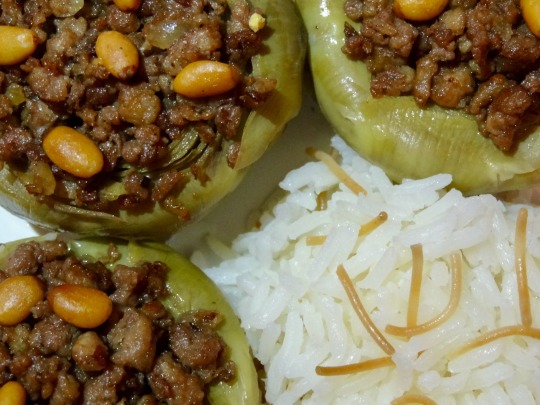
Tip: The white flesh at the base of the bracts (or "leaves") that you removed from the artichokes for this recipe is also edible. Try simmering removed leaves in water, salt, and a squeeze of lemon for 15 minutes, then scraping the bract between your teeth to eat the flesh.
181 notes
·
View notes
Text
Inside the Dirty Donkey
**Warning! This meta contains spoilers and speculation for S3. Do NOT tag Neil!**
Time to get comfy, folks. Get your drink of choice, be it a cupperty, coffee, or nip of sherry, and find a seat. You’ll definitely want to be sitting down for this one. We’re going to the pub!


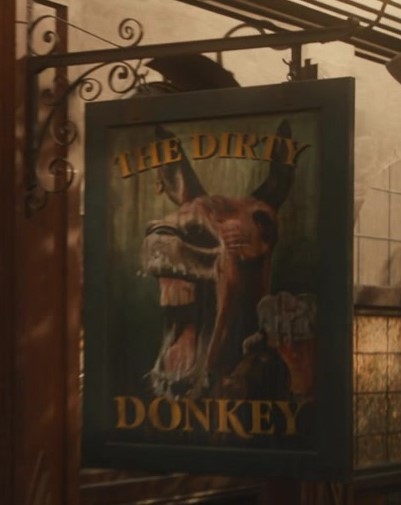
The name is apparently a favorite of NG’s, used in his short story “We Can Get Them For You Wholesale.” And it also appears in the Sandman AU.

In the short story above the protagonist is a jilted lover who tries to organize an assassin for his fiancé who is having an affair with another man at their shared workplace. He meets the ‘salesman’ of the firm he contacts at a pub called the Dirty Donkey, and it escalates from there. The story is freely available online, so you can search it up if you really want to read it, it won’t take long. It mentions a pale horse, which is usually what Death rides in on, and is appropriate in the context of that story.

The question we need to ask is how does the name The Dirty Donkey apply to the Good Omens AU? Are there any context to the name at all?
There are several meanings for a dirty donkey:
Its a slang or joke name for a black horse (not particularly a dark horse, that has a different meaning altogether)
A cocktail
A sex position (I’ll let you look that one up yourself…)

Probably the first thing we need to talk about, though is an actual donkey itself, in relation to Jesus, as S2 is full of Jesus references and hints to the Second Coming in S3. Yep, it was all there in front of us, but we were too focused on other things. If you remember your Bible teachings, Jesus rode into Jerusalem on a donkey, because he came in peace. In ancient times leaders rode horses if they went to war, or if they came in conquest. But arriving by donkey meant you came with peaceful intentions.
But Jesus didn't turn up in S2, you say. And certainly not on any hairy beast. Ah, but he did - metaphorically. Gabriel as Jim turned up - he came up the street, by (the Dirty) Donkey, walking through spilled blood tomatoes, then mentioned his arms were no longer sore (because he had been taken off the cross.) MrPeriod talks more about how Jim represents Jesus here, and it might be worth revisiting it at length another time, as there is quite a bit to unpack there.
There are also the two big golden lions perched on either end of the bar inside the pub, that look rather ominous. The lions are strongly connected to Jesus and his resurrection, representing his return. (I'm still planning to have a better look for more lions in both S1 and S2, but that is still a WIP at the moment.)
There is also the scene in 1941 where the Nazi zombies stagger into the Dirty Donkey and spy on Aziraphale and Crowley through the windows through to the book shop, but all they manage to get is “Banana, fish, gorilla, shoe lace with a dash of nutmeg.” It sounds a bit like a cocktail reference – well, the nutmeg is definitely a GO ref to a certain cocktail – but the cocktail called a Dirty Donkey has cinnamon in it, in the form of cinnamon schnapps, not nutmeg – plus chocolate liqueur and rum. So maybe not.
But perhaps the most important thing we have to examine is the conversation about Jane Austin that Aziraphale and Crowley have in the pub, in S2E2. Because its got so many levels you just about need a break for extra oxygen half way down. Ha! And you thought it was a couple of funny throw-away lines about how Aziraphale saw human romance...
OK, this is the section of dialogue we are going to look at:
AZIRAPHALE: If you're going to invoke fiction, you might as well do it properly.
CROWLEY: Properly?
AZIRAPHALE: You remember Jane Austen?
CROWLEY: Yeah. I'm not gonna forget her in a hurry, am I? The brains behind the 1810 Clerkenwell Diamond Robbery. Brandy smuggler. Master spy. What a piece of work.
AZIRAPHALE: She wrote books. Novels.
CROWLEY: Jane? Austen?
AZIRAPHALE: Yes!
CROWLEY: Whoa, bit of a dark horse. Novels, eh?
AZIRAPHALE: Yes. They were very good.
CROWLEY: Well. No, I'm just surprised, that's all. You think you know someone.
AZIRAPHALE: She had balls.
CROWLEY: Well....
AZIRAPHALE: Cotillion balls. People would gather and do some formal dancing and then realize they had misunderstood each other and were actually deeply in love.
Ready to dive into the levels on the Jane Austen conversation? Let's go...
Level 1: It’s a conversation about the novelist Jane Austen, and it sounds like they both met her, but they remember her in different ways – and Crowley’s memory is rather surprising!
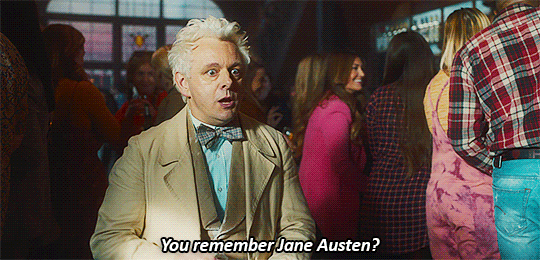
Level 2: There is a mention of a robbery. This makes the parallel with the 1967 scene in S1E3 Hard Times, where Crowley has a secret meeting in the Dirty Donkey to plan a robbery to steal holy water from a church. The robbery in the above conversation involves diamonds (are you taking note/s? This is important!) from Clerkenwell, a district of London of some notoriety. It was famous for it watchmakers and jewelers, but it was also the home of Oliver Cromwell, who has a link to the 1650 date mentioned in S2E1 and the Eccles cakes, to Charles Dickens (author of A Tale of Two Cities, a book of note for GO) Oh, and both times Crowley is wearing a "Tactical Turtleneck", which others have noted he wears when he is doing his own master spy work, such planning or discussing robberies, or sneaking into Heaven to rob them of information!


Level 3: There is Aziraphale’s idea about how a romance should be conducted, by hosting a cotillion ball with formal dancing, because he's read all those romantic novels by Austen. And we get to see that played out in S2E5 in the eldritch ball. Crowley's idea of a romance was to get caught in the rain and kiss, then - vavoom!

Level 4: Why mention this apparently fictional side to an author of fictional romance? Well, on one hand, it’s an interesting but dark set-up for a joke later at the beginning of S2E6. I ended up discussing it at length here, but the short of it is that it is our usual human custom not to speak ill of the dead, and this is a form of extreme black-and-white thinking. Here, Aziraphale speaks of the good/white side of Jane Austen, that is well known, but Crowley speaks of the black/supposedly forgotten or unspoken bad side of Austen.

Level 5: Here’s the S3 information. Have you been paying attention? Did you take note? The parallels were the robberies between a church, and diamonds? That she was a brandy smuggler? Do you know where they smuggled brandy from? And do you know where Austen actually lived? On the South Downs, overlooking the Channel to France…
Whew. I think I need a drink after that. Cheers!
[Edit: I've recently finished a meta on the Bentley and how that relates to black horses, and it's occurred to me why the ethereal lift, or "hellevator," is in the entrance to the Dirty Donkey. Black horses are symbolic spirit guides between the worlds of the living and the dead, so this makes the perfect place to put the lift!]
#good omens#good omens 2#crowley#aziraphale#good omens meta#good omens analysis#the dirty donkey#the pub#hard times#holy water heist#1967 crowley#jim as jesus#jane austen#cottage on the south downs#master spy#a sherry for me#tactical turtleneck#vavoom
66 notes
·
View notes
Photo

Reasons why old Sci Fi is still so cool. They had food in pill form- I’ll have another potato pill, but I’m just too full for another chicken pot pie. From Conquest Of Space, 1955

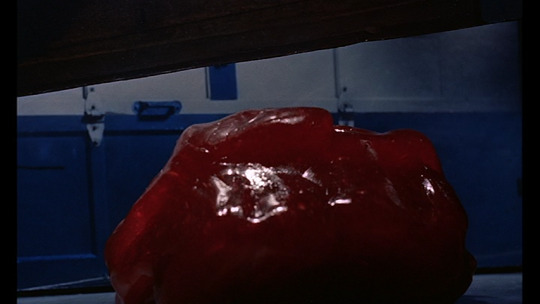
Movie titles aren’t the same, anymore. The classic, “The Blob” from 1958. Doesn’t it look like strawberry jelly? (And, don’t forget The Attack of the Killer Tomatoes.)

Oh, shit! It’s coming down the stairs!

There was no green screen or special effects, so they built creative sets. From Time Tunnel, 1956.

Living in space was fancy. From 2001: A Space Odyssey by Stanley Kubrick, 1967

They had homemade aliens. Looks like it’s a giant spring, Boing! The Monster that Challenged the World, 1953.

They had lots of space babes. Missile to the Moon, 1958.

My all-time favorite old Sci Fi movie- The Attack of the 50 ft. Woman, 1958.
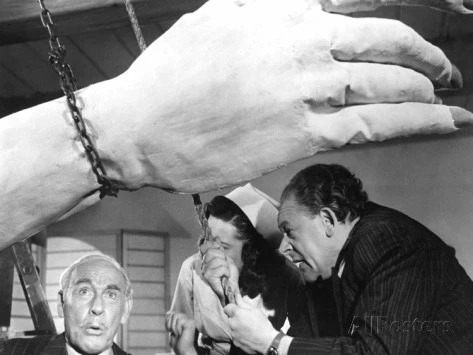
It’s the giant paper mâche hand that gets me every time. I wait for this scene.


Their little laser guns looked like plastic water pistols w/spark plugs. A ‘blaster’ gun from Forbidden Planet, 1956


Cool space fashion. Forbidden Planet, 1956 & Things to Come, 1936

And, look at this- didn’t those become the color Xmas tree wheels for the silver tinsel trees in the 60s? This Island Earth, 1955
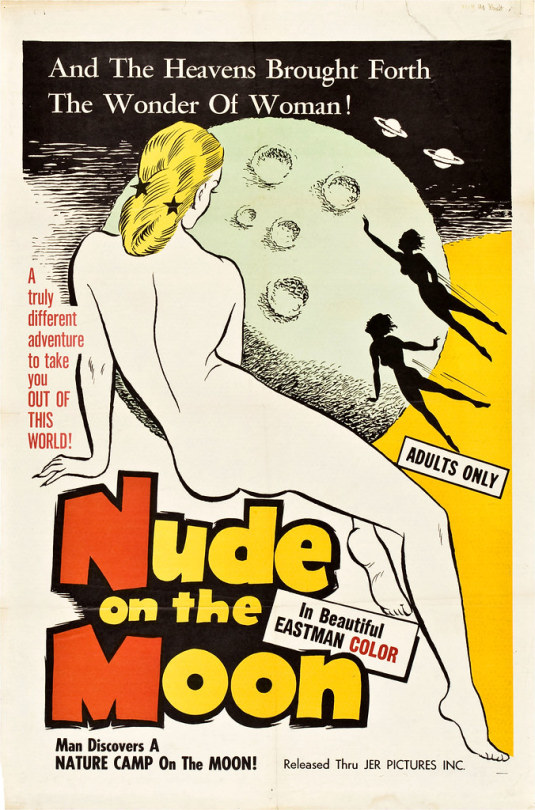

And, finally, campy Adults-Only Sci Fi. They didn’t need no damn space suit.
https://www.messynessychic.com/2013/10/02/10-reasons-why-vintage-hollywood-sci-fi-is-still-so-good/
419 notes
·
View notes
Text
The Last Name - oneshot
Pairing: Bucky Barnes x fem!Reader
Word count: 1.4k
Summary: There’s one more name from the past bouncing around Bucky’s head. One more scribble ripped from the pages of Steve’s old book. Another person to make amends with. Except this one is different: he can’t remember doing anything wrong. No murdering or enabling of evil plans. No threats or political conquests. In fact, Bucky can’t remember much of her at all.
Warnings: smut ***18+ only***, angst, alcohol, lots and lots of feelings hehe
Masterlist | Series Masterlist
Wowowow I don't even want to know how long it's been since I last posted! Let's just say I've been very busy participating in an actual social life, which is very tiring, omg how do people do it? Ngl I really love this one, lmk what you think!

Taipalsaari, present-day:
Dinner was a romantic affair. She felt human again, in a way that only fresh tomatoes and rosemary and Bucky’s soft lips could invoke.
He was so close. And he kept on touching her, all over, little brushes here and there, his warmth behind her as she stood at the stove like an extension of the steam ebbing from the frying pan. She was hypersensitive. Couldn’t concentrate on anything. Not with him like this: all soft wool and freshly washed hair. He smelled like her soap; she resolved to stock up a lifetime’s supply for him before they left for New York.
Bucky leaned over to taste some sauce, his hand coming to rest on her hip - the last straw. A drink. She needed a goddamn drink. The homemade vodka came clinking down from the shelf, clear and strong and lethal. That would sort her out.
“Where did you even get this?” Bucky inspected the bottle.
“The fish market,” she explained.
“Huh.”
They sat down with the food and drinks. The table had always had 2 chairs as companions, even before Bucky had found her. She’d crafted two sets of tableware as well, and used to alternate between them, one dirty set and one clean. Now everything got dirty at the same time, and they washed it all up together. She never thought she’d be so grateful to have more housework.
While they ate Bucky rested his foot against hers. She took another sip every 30 seconds in an effort to cope.
After too much food and half the bottle, they were twirling around the room, dirty dishes discarded and forgotten. There was time to wash them tomorrow. There was always more time. Bucky had placed his phone in a bowl, and a tinny little tune was dancing around the room. It wasn’t much use for a waltz, but at least it was something.
“I’ve missed music so much,” she said, pressing her nose into his collarbone, massaging the collar of his sweater with her lips.
“I’ll get you music,” Bucky said, raising their hands so she could spin. She threw her head back and laughed. “I’ll get you so much music.”
Shaking her head, she smiled like she really couldn’t help it. “I want to buy a record player,” he continued. “Did you know they were back in fashion? You can get them anywhere nowadays.”
“That’ll be nice,” she said.
“Mmhmm.”
He kissed her. Enthusiastically, at that. Leaning so far into her that she stumbled backwards, fingertips buried in his shoulders.
“Sorry,” she murmured.
“I’ve got you." He squeezed her waist. They stopped dancing. Bucky swayed occasionally, but nothing enough to distract from his lips. And his hands. And everything inbetween. Her body slowly became limper with his attention, more and more liquid as he became more solid, holding her tighter and firmer. She melted into a puddle at his feet, stretching out on the bed languidly as he bent to meet her. Laying half on top of her, one arm supporting his weight, the other free to touch.
“We didn’t . . .” he began, his voice low and crackly like he hadn’t spoken in days. His thumb traced the underside of her bottom lip. She fought the urge to coax it into her mouth. “When we were hiding . . . did we?”
“What?” she said. “Did we what?”
“Um.” Bucky’s ears went red. She’d never seen him like this before, so flustered, his words escaping him. She tried not to enjoy it too much. “Have sex?”
Her eyes went wide and then Bucky got worried, she could see it in the corners of his face, all the subtleties: the backtracking plan. He could still get himself out of this hole he’d dug, it was okay, they could still go back to normal, back to the moment right before he’d mentioned it, they could forgive, they could forget . . .
But she didn’t want to backtrack. She wanted to go forward. And keep going forever, until there wasn’t anywhere else to be.
“Oh,” she laughed, thin and awkward, trying to act casual. “No, we never did that.”
“Okay,” he said. “Good. I thought so.”
“Why is that good?”
Bucky didn’t hesitate. “Because I’ve been looking forward to it. To, um . . . being with you. For the first time.”
She could pretend to be disinterested. She could be coy, aloof. She’d done that before, with all sorts of people, important to her or not. But she found herself actually incapable of coordinating her face into one of indifference at that moment. She loved him. She loved him so much. He was sexy without even trying to be. And she’d never been at this point of intimacy before. The point at which all the mess, the tears, the embarrassment, all the blood and screaming and shame. . . the point at which they all fed into the space between them, charging it, making her body feel like it was about to be struck by lightning, thrumming, alive; she was feeling it all so much. She was feeling him so much.
Because that’s the thing with falling in love: there’s a moment, before you take all your clothes off, before you give yourself over, before the point of no return. There’s that moment when you feel the need to get completely naked. Not physically. Though it is a kind of shedding, of course, just of moral sensibilities, inhibitions. It’s a whisper across bedsheets: you don’t know what I’m actually like. It’s a scream from your core: I think I might be a terrible person. There’s something wrong with me, there’s been a mistake, you shouldn’t want to love me.
But please. Stay with me.
Bucky was different, though. He already knew the worst of her, there was nothing more to reveal. He’d heard her wails, seen her open fire, witnessed her cowardice. All she had to do was give in.
“Are you coming onto me, like, right now?” she said.
“Is it the wrong moment?” he said. “I gotta tell you, I’ve been thinking about it for two weeks. I’m not even gonna pretend anymore.”
“Oh my god, Bucky.” She sat up, rolling him away onto his back. She needed air. The cabin felt like fever.
“But you can tell me to shut up, seriously,” he said. “Just say the word and I’ll stop.”
“No. Don’t – I don’t want you to stop. Just . . .” she made a sound halfway between a growl and a whine, “you’re going to be the death of me, honestly.”
He looked uncertain again.
“You make me dizzy,” she whispered, looking back at him. “You make me so dizzy.”
He smiled. Touched a finger to her spine. “In a good way?”
“Yes.”
“You’re not going to faint?”
“I might,” she teased.
“I’ll catch you.”
“Yes.”
“Come here.” He pulled her on top of him, pushing her hair away from her face. His fingers went back to her lips and she took them this time, sucking, watching his eyes as they drooped and rolled.
“Fuck,” he groaned, lower than she’d ever heard him before. “Sweetheart.” The sound went straight through her, to her toes, echoing across the mattress, throbbing around the room. She felt him everywhere.
And he was hard, too. She could definitely feel that. She rolled her hips against his but he stopped her, gripping hard, head falling back. She gasped against his throat. It was so much. This was all so much.
“Please,” she complained. “Touch me.”
“Where?” he asked.
“Anywhere you want.”
So he touched her everywhere. She glowed beneath him, spread wide, surrendered. And he made her feel so good; so good she was honestly in shock. His face buried between her legs, mouth working in earnest rhythm, not stopping until she tugged at his hair, tight, so much tighter than she could ever intend, hips seizing beneath him. And him inside her, barely able to control himself, trembling but slow, so slow, too slow.
She gripped his hips and melded her lips with his earlobe. She needed to be heard.
“I can’t tell you how scared I was, Bucky,” she said.
“I was so relieved to see you,” she said.
“I thought I was going to be alone forever," she said.
“I’ve got you,” he replied, whining, desperate. “I’ve always got you.”
Taglist: @mayasreadingnook @writing-for-marvel @howlermonkey69 @ginger-swag-rapunzel @cuddlycalcifer @bambamwolf87 @twinerd14 @violets-library @hallecarey1 @cjand10 @navs-bhat @themorningsunshine
#bucky barnes x reader#bucky barnes x fem!reader#bucky barnes smut#bucky barnes fluff#bucky barnes angst#the winter soldier#angst#fluff#bucky barnes#bucky barnes x you#bucky x reader
199 notes
·
View notes
Text
LoSH Appreciation Week Day 4 - Monster of the Week

Monster, villain -- tomato, tomato... I did this comics page for my zine in Interlac #268, December 2020. Meglaro was the alien criminal bent on global conquest who escapes the Legion in Adventure Comics #303, triggering the search for a Legion traitor. Super-Mind Power including mental command, and the ability to destroy buildings, housed in an impenetrable bubble. He should have had a comeback or two. But no, he was monster of the week.
14 notes
·
View notes
Text
Fire Emblem Fates: Agere Leo Headcanons !!
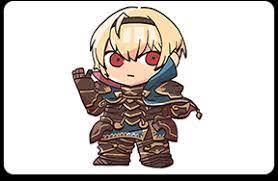
♕ His little age is around 2-6, though he mostly stays around 3 or 4.
♛ He’s a crier. Sleepy? Cries. Lonely? Cries. Bored? Cries. He can be a very clingy kiddo when he wants to.
♕ Ironically, he’s also the independent type. If you place him in a enclosed space with books and toys that jingle he can stay put for hours.
♛ He claims he can read by himself… But being honest, his baby intellect can best handle those cardboard books. (Especially the touch and feel and the look for the hidden object ones-)
♕ Doesn’t actually like physical touch. Camilla found out about his regression when he started tearing up and pushing her away after she tried to give him a hug.
♛ However, he actually loves being picked up, put on swings, sitting on his carer’s lap. He gets overstimulated with a lot of pressure, though, so hugs aren’t preferred by him.
♕ Elise wants to be his main caregiver SO BAD. But that role goes to Odin and Niles (mainly Niles), who treat the baby prince like they’re narrators of a story book. Needless to say, Leo loves it.
♛ Odin takes care of the stimulation: playing, reading, his personality makes the most interesting voices for characters. Niles prefers handling the more domestic duties: cleaning, bathing, cooking, Prince Leo doesn’t deserve any less than the best, after all.
♕ He still likes tomatoes. And by like, I mean that he still adores them. Once he snuck out regressed at night and ate 2 and a half tomatoes before he was caught by Laslow and Peri. (Xander scolded Peri for bouncing Leo and keeping him awake. She loves baby princey)
♛ He’s actually pretty intimidated by the horses, so he never usually goes by the stables. The few times he gets close to a horse is when they’re brought out for training or feeding. He brings his crayons and sketchbook whenever Elise takes her horsie for a ride.
♕ In the Birthright route, Leo finds himself regressed often, even when he tries to suppress it. Sometimes he simply collapses with stress, so Odin and Niles have kept little gear in the places Leo spends his time most.
♛ He cries a lot about his big brother and younger sister, he has nightmares where he acts like a witness. He wakes up in a cold sweat, and Camilla comes over due to his cries and screams. He often breaks down in her embrace, crying out for Big Brother and Sissy.
♕ In the Conquest route, Corrin is added to the close circle of his regression. Corrin was surprised at first (Leo didn’t fully express his regression until Corrin decided to side with them) but then fell completely in love with their babier brother! How could they not?
♛ In the Revelations route, Takumi and Leo grow more close. They still act cold and rival against each other when they’re big, but if anyone can understand Little Leo’s behaviors, it’s Takumi.
♕ Corrin makes a lot of play dates between both princes. (Leo will never admit that he genuinely likes them)
♛ He’s still quiet, as in, he doesn’t even babble. He responds in humming or with body language, other than that, he stays silent.
♕ 1000% a tether kid. He had a bad habit of biting others as a kid and thus likes to bite things while regressed. He has his own chewable paci and he uses it a l o t .
♛ When asked about how he’s feeling, if he says “I dont wanna talk about it”, then it’s because he’s regressing. It’s become like a code for his family and retainers.
♕ Of course, he isn’t public about this, but his family all know. Xander especially loves spending time with his baby brother, even if he has no flipping clue of what he’s doing half the time.
9 notes
·
View notes
Note
Wait... Do the Gerudo still live around the ancient, infinitely flowing spring rock here?
If so, then I can't help but feel like Gan has very little excuse for his people not thriving.
It's very possible to plant a decent number of crops in the desert so long as you have ready access to water & knowledge of how to plant them.
A lot of the ingredients we find in the games would be able to, in fact.
Hylian Tomatoes, any Pumpkin, any Carrot, any Radish, Stambulbs, & Tabantha Wheat.
This, plus the things we know can grow there, Wildberries, Voltfruit, Dazzlefruit, Shock Fruit, Sundelions, Hydromelons, Warm & Cold Safflina, Spicy Pepper, Palm Fruit, & Zapshrooms. Not to mention the Cave Fish, Brightcaps, & very rare Truffles that you can find in the caves.
Yes, it'd be very difficult, but with the time & effort, the Gerudo should be able to thrive every bit as well as Egypt or Mesopotamia.
In a lot of ways, if the water from the fountain truly is infinite, then they should actually be as, if not more prosperous as a kingdom that even Hyrule. So, I just... *growls in frustration*
Sorry, this is one of those tender spots...
By here, do you mean like… in one of my stories?? I’m assuming you do, or TotK? Because OoT/WW/TP Gan’s Gerudo are nomadic and don’t have infinite water supply.
If you’re talking TotK, I… have no clue lol.
But if you’re talking my stories, then I’ll go into some detail.
In Golden Mercy, Ganondorf is from OoT. He’s used to hunting for resources. Hyrule’s appeal is very much due to its abundance, based on how he acts in WW. But when Gan travels to the Calamity timeline and meets Nabooru and her tribe, it’s a completely different Gerudo. They’re a prospering civilization, they have multiple settlements and a thriving culture in the desert. Gan is honestly so satisfied by it that he settles down and has a family. Hyrule is just a neighboring kingdom, and while he might covet its landscapes as they’re so different from his own, it’s less, well, dire for lack of a better word. The main driving force that pushes Gan to start the Imprisoning War that leads up to Hyrule Warriors is because Gan learns that the Triforce exists in this timeline too and that is too enticing to ignore. Gan is selfish and power hungry, after all.
In TotK: Hero of Shadow, it’s more up in the air since TotK is bare bones on Gerudo lore. Seems more like a conquest thing, Gan wants to spread his power and influence, maybe he wants resources too, idk. Totk Gan strikes me as a conqueror, as someone who craves challenge and thinks the world belongs to him. (Whereas OoT Gan, while wanting to claim power for himself, seems to come from a bit more desperate circumstances)
5 notes
·
View notes
Text
Conquest for bread? Why just bread? Why are y'all so boring?
Give me a conquest for a grilled cheese and tomato soup.
8 notes
·
View notes
Note
Hello! :)
So… What about
Glance, Formal and Favourite for Nat and Maran? :3
(and Miriam too if you'd like, I'm curious!)
hello!! sorry for asking for asks and immediately disappearing. we had a massive tomato harvest in today (multiple 5gal buckets massive) (last of the season) so I was unexpectedly processing that all day!
anyway. here goes! I haven't thought about maran in a hot second ngl
[prompt list]
cut for length because this became a bit of a character study as usual
glance: at first glance, what stands out most? what's their distinguishing feature?
Nat is stupid short. Dwarva are short to start with; Nat is short for a dwarf. She had tried to make up for her stature by taking her marks for her carta clan bolder and earlier than most, and wearing her conquested jewels (her locks) proudly in her ears and face. Prove she was worth fearing, even if she was small. She's still first noticed to be short.
Maran has bright silver hair. When she was little, she had been towheaded. Her hair had darkened over the years, as most towheads do, though she always preserved a few white-gold strands. Until the Conclave. When she woke from whatever funny business had taken place, her hair was a metallic silver. It does gradually fade through the events of Inquisition, coming close to returning to her natural dark brown with white-gold strands - but the events at Adamant turn those white-gold pieces permanently metallic silver.
Miriam is a Hawke. I mean, she's a Fereldan apostate mage with no fear and a disastrous ego. It's more a question of who is looking at her than what is universally most noticeable. She wears her kaddis, sure, despite not having a mabari to partner. She wears much less clothing than most of the Marchers, being so used to the colds of Lothering. She carries her fuckoff big staff with a bloody statue on the end of it. She has lightning scars up her arms. It depends who's looking.
formal: what's their formal look? do they like dressing up? do they have different looks for different occasions?
Nat has struck a delicate balance of Paragon and Commander in her formal dress. Technically she ought to dress according to her most relevant title at any given function - but she is not a thousand disparate Natias. She is Warden Nat Brosca, Commander of the Grey, Paragon of Duty to Orzammar, Advisor to the Throne of Fereldan, and Sister of the King of Orzammar. In broad strokes, as I still want to get an actual sketch done sometime, she wears the veil and gems as befit a Paragon and Warrior of Orzammar, and her formal warden blue and greys. Nat enjoys demonstrating her power. The clothes...not as important. In time, putting on her formal uniform becomes a ritual to center herself in her body before she has to go Be The Hero.
Maran knows how to dress well. She knows how to dress for an occasion. She enjoys the feeling of rich fabrics. Enjoys the drape and flow. Enjoys feeling correctly feminine - and a little like an imposter. Like she's playing dress up in her older sisters' dressers. Like she's stolen the fine silks and broad skirts and any moment her mother will catch and scold her. Maran loves to play the lady she should have been raised to be, had her parents fewer daughters to marry off and better matches to be made. But it will only ever be playing.
Miriam will not wear a dress. Nope. Not doing. So she fails at dressing formally (or even appropriately) in most contexts. Good thing no one argues with the Champion. (The last argument might have ended in an irate noblewoman slowly thawing off the side of her Hightown mansion. Maybe.)
favorite: do they have a favorite article of clothing or accessory? what is it? what is the meaning? do they always wear it or store it for safekeeping?
Nat is pretty simple - her oath. She has places she could store it, if she wanted, but it doesn't feel safe to leave anything she cares about away. Her oath hangs around her neck, every moment of every day. When she leaves to find the Cure, she adds a scrap of fabric tied around the chain. She's a terrible mother. A scrap of her daughter's blanket reminds her to come home, better.
Maran hasn't seen her favorite dress in years. It was once her grandmother's wedding gown, carefully cut and sewn and embroidered with snowdrops along the hem. Then her mother's, the sides let out to accommodate a just-couldn't-wait growing stomach. Then her sister's - and her sister's - and her sister's - and her sister's - and her sister's. Then it was too big for Little Mar. Then she wasn't enough of a lady. Then she took herself to britches - and then she left home. It might still be in her mother's cedar chest, waiting for a white-gold bride. It'll have to wait another twenty years, if it is. Maran has been a bride already, in muddy boots and heavy blue woolen britches, a snowdrop hastily (Badly) embroidered on the hem.
Miriam would never admit to enjoying anything ever. She's kind of a bitch. And horribly mentally unstable. Probably would do better if she could allow herself to feel joy not related to murdering templars and/or fucking her possessed boyfriend. Is that boyfriend Justice or is it Anders? Your guess is as good as hers.
3 notes
·
View notes
Text
Manifesting 💘anon because of the new heartbeat conquest webtoon episodes and I've haven't heard of them in a long time.
Bro please talk to me I miss you and I wanna speak about heartbeat conquest
#Heartbeat conquest#webtoon#the tomato can#I love you 💘-non#Heartbeat Conquest#Diana#Sezar#Bambi#Cassian von Alexia#heartbeat conquest#heartbeat conquest x reader
1 note
·
View note
Note
The runes on Excalibur 👀👀
They’re Nordic, wouldn’t they be Anglo Saxon runes based on the time? Or some sort of Celtic equivalent?
Which. Does the sword = norse or like, type of sword ≠ Norse???
Basically. Just a general Excalibur question and whether it’s historically correct.
Bonus: What do the runes even mean, I know they’re a random sequence and not what they say it means in the show buuttt…. 🤷♀️
The Problem of Runes
The runes used in the show are Elder Futhark, an anglo-saxon/norseman language in a time when one of the larger enemy forces are the anglo-saxons. Which… doesn’t make a lot of sense. Interestingly, should the sword exist, at the time they'd have used Latin letters, since Romans had already come and begun slowly making people Christian. Funnily enough, Old English only came after Arthur's time in real history. They most likely were also speaking Old Welsh/Hen Gymraeg. I think I may have mentioned it before, who knows, but language is diverse. Language in a post-roman conquest after rome also leaves but anglo-saxons haven’t shown up, even worse. Likely, it wasn’t all simple as it is in the show (due to audience understandings) and likely each Kingdom had its own language/dialect and the different parts of their land also had their own dialects. Likely, around Camelot to Mercia, and back to Caerleon, it’s likely that the language would have links to Latin, at least in the upper class due to Latin being the language of government and writing, but it wouldn’t be the only thing about.
But back to Futhark, my base understanding is that in Britain, there is roughly a period between 400-900 in which artifacts with Runes of this type are found, although they did exist up to 1066 until the Norman Conquest, while King Arthur exists anywhere from 420-1100 (give or take - the show has of course anachronisms[Tomato / Potato / Sandwhich / Silk dresses for Morgana], but it also, then, has dragons).
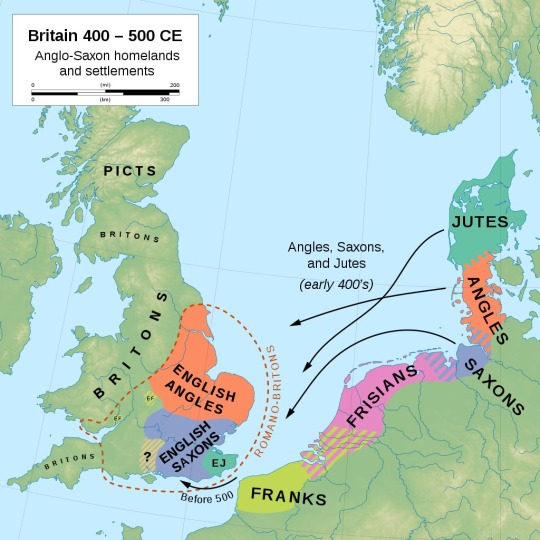
Also, Ogham may be used if they wanted a more ‘mystic’ feel of inscription. The language is attributed to the Druids, the irish, the pictish, and would use 20 letters.
According to the High Medieval Briatharogam, an irish literature explanation for kennings on the ogham alphabet, trees can be ascribed to specific letters. There is scholarly debate, however, if Ogham is a cipher based on either Germanic runes, Elder Futhark, Greek alphabet, or even Latin. This is due, largely to the “H/Z” letters present in Ogham, but unused in Irish and the vocalic/consonantal variant of “U” vs “W”. And again, at the time, Latin in Roman Britannia, specifically southern and the west, would be prominent (and outside of Ireland, the highest concentration of Ogham is in Wales).
T - Tinne - Holly = Overcoming challenge
A - Ailm - White Fir = Look to past for future understandings
C - Coll - Hazel = Inspire others through skill/wisdom
E - Eadhadh - Poplar = Face challenge with determination
M - Muin - Vine = Trust intuition/Relax
E - Eadhadh - Poplar = Face challenge with determination
U - Ur - Heather = Healing and respite time
P - Peith - soft Birch = New beginnings, change, good fortune
-
C - Coll - Hazel = Inspire others through skill/wisdom
A - Ailm - White Fir = Look to past for future understandings
S - Sail - Willow = Period of learning
T - Tinne - Holly = Overcoming challenge
M - Muin - Vine = Trust intuition/Relax
E - Eadhadh - Poplar = Face challenge with determination
A - Ailm - White Fir = Look to past for future understandings
U - Ur - Heather = Healing and respite time
A - Ailm - White Fir = Look to past for future understandings
Y - Eamhancholl = wisdom/understanding
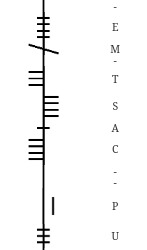
(Notably Ogham does not have a ‘w’ as a letter so substituting of the sound /u/ is done or with a soft /v/ sound - same with the dual C as there isn’t a K (from what i can tell))
Translation
Based on Arthurian ‘lore’, there are two base sayings that are inscribed on Arthur’s blade “Take me up, cast me away.” This comes from Tennyson'sIdylls of the King, within which the sword is inscribed with the "oldest tongue of all this world". Should the sword be pulled from a rock and anvil, there is often the inscription accompanining it saying "Whoso pulleth out this sword of this stone and anvil is likewise King of all England" (or something to that degree) which is seen in Malory’s works.
To receive an answer of what should be on the sword and what is, is very different. And I am shamelessly pulling from Merlin.fandom as this has been a conversation before. “The runes on the Excalibur in the picture say 'ahefemupwiithstr' which isn't really a word” (https://merlin.fandom.com/f/p/2608657942446217361) However, that’s not to say someone didn’t solve what it should be written as “Translation for "Take Me Up" • Tiwaz - Ansuz - Kenaz - Ewhaz • Mannaz - Ewhaz • Uruz - Perthro • / Translation for "Cast Me Away" • Kenaz - Ansuz - Soliow - Thurasaz • Mannaz - Ewhaz • Ansuz - Wunjo - Ansuz •”
Now, these runes given for the saying do indeed spell out Take me up/Kast me away, this is written with the intention of spelling the words completely assuming no ideography (using what the letters mean[as you ask] rather than what they show: Tiwaz meaning Tyr/Sky god + order/justice / Ansuz meaning As/Odin + order/inspiration/sovereign power / Kenaz being Beacon/Torch + knowledge/tradition/hearth / Ewhaz being Horse + transportation/Steady progress/change / Mannaz meaning Man/Mankind + The Self/human race/mortality / Uruz being Auroch/Ox + Physical Strength/speed/untamed potential / Perthro meaning Lot Cup/Vagina + Feminine Mysteries/occult/secrets/initiation /// Soliow being The Sun + Success/honour/health / Thurasaz(or redoing Tiwaz potentially in the spelling of it) meaning Thorn/Giant + defense/conflict/catharsis/purging / Wunjo being Joy + Comfort/pleasure/harmony --- In my understanding of these, it feels like “take me up” in these runes has indications of taking a throne, bringing in order to the human race, whereas “cast me away” has similar lettering but implicates successes having been done and a conflict having been finished, thus ‘casting away’ the sword once the battle is done).
The show, as mentioned above, has the engraving that translates to 'ahefemupwiithstr' and I’m going to save myself a bit of research and info dumping by going to another source, and I also, unfortunately, don’t know how to link things in Tumblr so we get to suffer screenshots - but do check out the original link: https://dollopheadedmerlin.tumblr.com/post/149429230626/so-guys-im-thinking-of-making-a-replica-of#notes,





Sword Types
Anglo-Saxon swords comprised two-edged straight, flat blades. The tang of the blade was covered by a hilt, which consisted of an upper and lower guard, a pommel (often decorated depending on need and use), and a grip by which the sword was held.
At the time BBC depicts Merlin, the Anglo-Saxons have yet to conquer Britain, thus implying the soldiers wouldn’t likely be using an anglo-saxon sword, however, they could be considering the flow of ideas surpasses the flow of war I suppose.
Excalibur has been depicted from everything from a Roman Gladius (likely in earlier prose when King Arthur existed near the time of Post-Roman Britain, and there are stories with King Arthur and Julius Ceasar meeting, which is very… interesting), to a medieval longsword. Based off the hilt and pommel of Excalibur that we see, it appears to be almost a form of Claymore/Broadsword or Longsword.
However, these range roughly 1100-1700s. In the myths we have, Excalibur is never actually described. However, in modern depictions (film and artwork) it is typically depicted as a form of arming sword, that is, one-handed straight+long-bladed with a double-edge with a crossguard. Which, is reasonable, this style was very popular in the middle ages.
The depiction of Excalibur, in my opinion, is fitting to the 10th and 13th century forms of such swords (the 13th century has that fancy pommel at the end that the sword has in the show). However, your ask was more is this sword norse? Which, the depiction given is kind of in answer, due to the style given at what should be 5th century >< which may look something more similar to this with shorter crossguards while maintaining the circular pommel. Also to note, the term Pommel connects to anglo-normal “little apple” as it was an enlarged fitting at the top of the handle.

#merlin and arthur#the adventures of merlin#bbc merlin#excalibur#runes#elder futhark#anglo saxon#ogham#swords#timeline schenanigans#analysis#arthurian lore
15 notes
·
View notes
Text
Ranting about The trio’s introduction that will never be not through my throat

Playing Hidden Truth will forever not be not the most painful experience I had to go through.
Look. As much as I love the Time Travel trio and as much as I think that Fates saved their characters (except Owain. Owain was already awesome so him as Odin was just him being more awesome. But Inigo and Severa had some serious character redemption)... I think the way they arrived in the game just *****. Because it was one of Fates’ biggest plot hole.
The main problem is that Hidden Truth has WAAAAY too much important informations to remain a simple DLC. It’s not even comparable to Awakening Future of Despair because Future of Despair and Infinte Regalia are bonus maps with implications of world building that makes stuff cool but is overall not really THAT important for the plot. Sure we know what happened to the Shepherds of the future killed by Grima in the failed timeline and we know where Morgan comes from but those informations are more of a sub plot since the only real plot relevant Time Traveler in Awakening is Lucina. BUT HIDDEN TRUTH !!!
It mentions the human half of Anankos, who is Corrin’s true father, many stuff about Valla and Lilith and so on and so on. AND most importantly : IT MADE THE TIME TRAVEL TRIO TOO MUCH OF AN IMPORTANT CHARACTER FOR THEM TO JUST SIT AROUND IN NOHR AND WAIT TO BE INTRODUCED IN THE LATTER CHAPTER OF FATES AND REVELATIONS!!!
Seriously ? Anankos send them to save the world by helping his child to kill him and they just.... stay in Nohr to brush Lady Camilla’s hair, cook tomatoes for Lord Leo and prepare tea for Lord Xander... EXCUSE ME ?!
I mean yeah Anankos never mentionned who was Corrin but the DLC does mentions that Anankos’s kid was in Hoshido then got kidnapped.... SO UNLESS NOBODY EVER MENTIONS CORRIN BEING THE STOLEN CHILD FROM HOSHIDO THEY HAVE NO EXCUSE TO NOT KNOW THAT !! AND THAT’S ESPECIALLY TRUE ONCE YOU PLAY CONQUEST SINCE CORRIN ALREADY LEARN THE TRUTH ABOUT THEM NOT BEING NOHRIAN!!! WAS MAKING THE CONNECTION REALLY TOO HARD ?! And don’t get me started on Lilith... seriously ? They worked at the same PLACE!! Unless Lilith never interacted with others servants because she stayed with Corrin in the fortress... but there’s a weird thing about not being sure whether or not the Trio met Corrin or not due to Odin and Selena complaining that Corrin doesn’t recognize them while Laslow is the only one who has a somewhat normal introduction that doesn’t make you question things.....
But yeah. This made them way too much of an important character for them to stays minor characters but I am sure that the writer wanted them to come back into the sidekick squade cause they don’t have much impact on Fates’s plot asides from helping Corrin in maps in Conquest and being recruitable in Revelations.
While I understand that them being not recruitable is supposed to show that they have loyalty and stuff... MAKING THEM NEUTRAL WOULD HAVE MADE MORE SENSE SINCE THEY ARE SUPPOSED TO BE HELPING CORRIN!!! This could have been done by them discovering that Corrin fits the description of the child Anakos told them about and deciding to join them for that in Birthright and their support tackling this topic in Conquest. But as I am convinced that they wrote Hidden Truth AFTER Revelations since it was the 2nd DLC wave (and the last for overseas release) i have a feeling they just thought it would be cool to give them such a connection. I says that but since they always hint at their support, at least in their S support with Corrin that they will have to leave, MAYBE it’s not entirely exact either. Seriously ? was it that hard to make them recruitable in Birthright, not change a thing for the other routes, but give them special supports depending on which route you have ? THEY DID IT FOR AZURA COME ON!! They could have did for those 3 and also have them involves just a liiiiittle bit more in Revelations plot but NOPE. WAS NOT GONNA HAPPEN!
Still would have made more sense for them to be Corrin’s retainer but I am sure that the writers did not intended that. They just wanted them to be back as side character while not giving them to much of a spotlight in the main story. HA HA HA!! can’t believe they failed that. Sorry, no. You gave them too much importance for them to not either be Corrin’s retainer or neutral. That’s just the logical consequence of what should have happened.
Another solution would have been to insert the three as the ACTUAL children of Cordelia, Olivia and Lissa. Remember : none of the future kids is the actual Shepherds kids due to multiverse. They would be hence the actual children from Olivia, Lissa and Cordelia but their name would be different due to their mothers thinking that they should name them differently from their future counterpart and thus their actual names would then be Odin, Laslow and Selena. There it would then explain why on earth Laslow and Selena got married again when you already had paired them in your Awakening file and why they did not even mentioned be together in that timeline and would solve the whole thing about whether or not it count as cheating that they are married another person than in Awakening or even having to make it make sense by even more multiverse by imagining that the canon timeline took place after they traveled to Fates hence that they themselves are from a timeline where the canon events took place and AJHHPKJVHGCUIUOUYCHJVJ -- my head... But the problem here is that it would also be against the writers plan of Fates being before Awakening and after Awakening at the same time (time travel cursed thee) since that would make Hoshido and Nohr countries that developped after Awakening and still exist along with Ylisse but were never talk about and in terms of world building it is less good compared to imagine that Hoshido is the ancestor place of Lonq’u and Say’ri’s homeland, Cho’sin, and that Nohr was at some point in the local localizations of Ylisse or any country that as Western aspects....
But since we can’t have them joined Hoshido because loyalty nor them being Corrin’s retainer due to plot importance nor make them being the Shepherds girls’s actual children without having to create another interruption in the FE franchise’s timeline that is already a real mess to understand , the only way of making them comes to Fates’s universe without falling into the trap was to.... give them a silly reason to be here.
You heard me. That’s the only way. Them being here because of their stupidity was actually, not a better, but a LESS damaging idea of insering fan service characters.
So if I had to rewrite their arrival on Fates in a way that doesn’t create any more plot hole than the one cause by the sole existence of the Invisible Kingdom.....
I think I would do it this way :
- In Awakening, after Grima is defeated all of the kids try to find a way so that they could get back to their timeline in order to rebuilt their own world since the Grima of the failed timeline was killed in the canon timeline, it means that the failed timeline has no Grima anymore and they still wish to get back to their true Ylisse and offers their parents a proper burial.
- They split to search for ways and one of the team is composed of Owain, Severa and Inigo. So they travel and somehow manages to find a time crystal that can help them open a Outrealm gate to their timeline.
If I had to write like a DLC though, this format would make the info I mentionned above being part of the expositon given.
In a DLC chapter format, you would have the thing open with Severa scolding Owain and/or Inigo for having messed up and explaining the random info that I mentionned above. They obviously don’t recongnize the scenery but they know it’s not their dimension. So they would hence try to gather info about the place they are in before having to fight ennemies and then by the end of the DLC level, we would have a dialogue where they learn that they are in Nohr. Owain, being the historical nerd he is would explain to the two that they made a mistake, activated the time travel crystal by accident and ended up traveling in time again but not to their future, but to an even more distant past than the Awakening canon timeline. As a result, the 3 would be downed, not exactly fine with being stuck in a world that is even more distant to their future than 10 years early. I mean being in their shoes, travelling 10 years before they are born, even if it is in a parallel world, is not exactly a situation that did not cause weird stuff. So imagine that now they are in a world where not only their parents, THEIR ANCESTORS MIGHT NOT HAVE BEEN BORN YET!!! So they would try to find a way to make it back to the world of Awakening aka the canon timeline since their priorities would be to reunite with their friends and also because coming back to the failed timeline without them is not exactly a good idea since they planned to get back there together, all 12 (I am obivously not counting Morgan for obvious reason that I will explain later) and hence they would work to find a way to get out of this pinch. But because of Owain’s chunibyo, they end up taking covers name and changes their apperance. Owain would try to justify it by pretending that they have to be careful of their actions in this world as if they do some important changes, it will create a new future and so on but he actually just wanted to use secret identity like Luci did by pretending to be Marth to sound cool too but since it’s a silly reason he has to come up with that nonsensical excuse that doesn’t really convice much Severa and Inigo, but they go along well and comes up with the new identity stuff with changing their appearance to fit the landscape and Owain would take the opportunity to become a sorcerer because the conversations that they had in Hidden truth would still happen. And then due to shenanginans and sue, they end up working for the Nohrian Royals, explaining why they can’t be neutral, would stay and still not put too much of a focus on them. Maybe them discovering that in order to travel back in time they must go to Garon’s castle because they heard rumors about the castle having magic artefacts that can allow to travel across the timeline or that they have to go through it so that they can find the Dragon Gate that allows to time travel (as prouven by Before Awakening).
See ? That sure makes a lot of the plot stuff about them comes off as silly and stupid but at least no plot hole and no weird stuff such as Anankos wanting them to change their identities despite no one knowing them (or maybe Anankos knew their child would reincarnate into Robin idk) and so on and so on. And it doesn’t give them an actual purpose that contradicts the plot. They would have their own reason, trying to return home and because of this, instead of making them retainer from a long moment, maybe fresh retainer of new recruites for the Nohrian army. And no more me wondering about how none of them, espiecially chunibyo boi, not commenting on Nohr and Hoshido’s name when Chrom’s great knowledge in history made him comment on how “there is not a single person who hasn’t heard about Nohr and Hoshido, the mythical kingdoms”. There it’s all fixed.
And if I don’t mention Morgan it’s because... well you do know that it is pretty much acknowledged that M!Corrin represents Brithright/Hoshido while F! Corrin represents Conquest/Nohr. Welll... that means that technically the three of them were envisonned comming from a timeline where Robin is .... female.
“What ? What makes you say that ?” Robin is Corrin’s reincarnation regardless of gender. In their support and interactions with Corrin, at least for Odin and Laslow, the support definetely hints at the one that they had with F! Robin. Indeed in his conversationw with M! Robin, Owain mentions his own fanfiction while he seeks F!Robin’s help to find a name for his sword. In Fates, with bothe Corrin, Odin seeks their help to name his pose. In his support with M!Robin, Inigo complains about not getting girls, while in his support with F!Robin, he hits on her and then the A support is he giving salve around, including to her. Just like the conversation he has with both Corrin except the writer remplace him hitting on Corrin with him asking him to be his wingman when Corrin is male. But well it’s pretty obvious that those are references to their conversation with F!Robin and that means that they copy pasted the support they wrote for them with F! Corrin for M! Corrin and changed a few things, hence why no reference to the kind of support they had with M! Robin but only with F! Robin. Moreover in Selena and Laslow’s B support, the japanse version has Selena stares at him until he is embarassed, which is exactly what F!Robin did to Inigo in their B support. And Hidden truth also made a whole point about Inigo wandering aroung with salve in his bag while and Severa hinting at him not liking being stared too much... (I wonder if F!Robin taught her the trick). So yeah that makes me think that regardless of your Corrin’s gender, they were supposed to come from a universe where Robin is female due to the writers having most likely decided to use F!Corrin as a default for Conquest and most likely based most of the supports around her before copy pasting to M!Corrin.
Anyway, there you go. An actual reason to have them here. Is it as dumb as it originally was ? Yes. Is it even less of an actual good reasons for them to come here as it originally was ? Yes. Does this make it even more appear as just a silly excuse to have them being in Fates just to appease the fangirls and fanboys ? Yes.
But at least. It makes more sense. them being here for stupid reason is at least finally acknowledged fully. They still are gonna be incompetents fools but not for the same reasons.
#fire emblem#Fire Emblem Fates#fire emblem if#fire emblem awakening#fire embem awakening#awakening trio#fates trio#time travel trio#severa#severa fire emblem#fe selena#fe severa#owain#fe owain#odin#selena#odin fe#odin fire emblem#inigo#fe inigo#owain fire emblem#inigo fire emblem#fe laslow#laslow#laslow fire emblem#fire emblem kakusei#I have just realized#but many of the elements that made think of F!Robin comes from Laslow#did they really invested all of Inigo's personality in his convos with F!Robin ?
12 notes
·
View notes
Text
All's Fair in Blood and War (1/3)
Mesoamerican civilizations are often forgotten in discussions of ancient imperialism. Controlling the most powerful empire in central Mexico during the 15th and early 16th centuries, The Aztec Empire grew quickly in territory and influence, largely due to the civilization's religious beliefs and practices. Let's explore how Aztec religion catalyzed The Aztec Empire's bloody expansion through romanticized ideals of war and conquest!

Ancient Aztec religion was undoubtedly polytheistic. Although minute details concerning Aztec gods and goddesses are debated among scholars, Aztec worshipping of hundreds of deities is widely accepted as historical canon. Individuals living within The Aztec Empire likely had patron deities, chosen to reflect personal desires, but two deities held universal importance through The Aztec Empire: Huitzilopochtli, god of war, and Tlaloc, god of rain. Consequently, the Aztecs heavily revered a duality of war and agriculture. Instigating war was viewed as essential in honoring Huitzilopochtli. Maintaining high yields of maize, beans, tomatoes, and pumpkins was viewed as essential in honoring Tlaloc.
Source: Solís Olguín Felipe R, et al. The Aztec Empire. Guggenheim Museum Publications, 2004. Print.
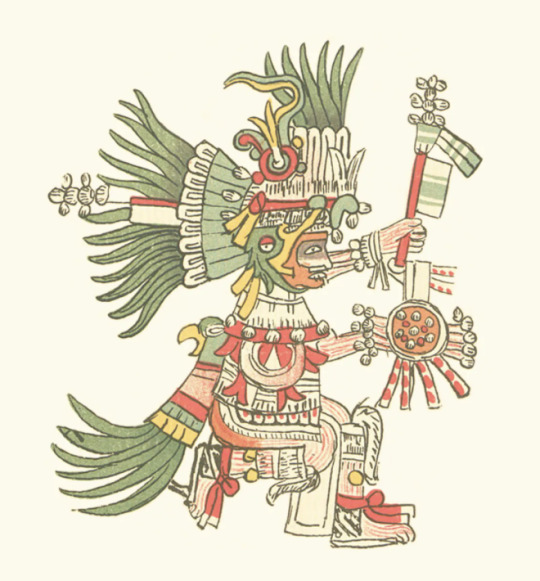
Image Source: Meehan, Evan. “Huitzilopochtli.” Mythopedia, Mythopedia, 2022, https://mythopedia.com/topics/huitzilopochtli
In Aztec mythology, Huitzilopochtli led the Aztecs to Tenochtitlan, later serving as the civilization's capital city. Huitzilopochtli demanded constant veneration through violent sacrifice after every war victory and defeat. Aztec warriors who died during battle were believed to be reincarnated as hummingbirds, the highest honor bestowed by Huitzilopochtli. Desiring to please Huitzilopochtli, the Aztecs remained in a state of war that subsequently built an expansive empire through conquering surrounding tribes. Aztec men were raised to become warriors, honoring Huitzilopochtli through fighting until their violent demise. This brutality-centered mindset, deriving from religious idealizations, motivated the Aztecs to conquer central Mexico. In other words, The Aztec Empire's expansion occurred to serve a patron deity of Aztec mythology.
Source: Bassett, Molly H. The Fate of Earthly Things: Aztec Gods and God-Bodies. First edition., University of Texas Press, 2015. Print.

Image Source: Dozier, Amy. “Huitzilopochtli.” Dribbble, Dribbble, 2023, https://dribbble.com/shots/4132073-Huitzilopochtli
Expansion of The Aztec Empire did occur, in part, from the civilization's selfish desires for power and control, but primary need for expansion remained focused on piety towards Huitzilopochtli. Unlike many European empires' exploitations of civilizations for nationalistic gains, Aztec monopolization over territory proved to be almost entirely spiritual. I guess humans have always had a history of deflecting blame onto others, divine or otherwise, to avoid facing the consequences of their actions.
#imperialism#ancient history#history#colonialism#imperialists#aztecs#aztec empire#mythology#aztec mythology#mesoamerica#the americas#mexico#the god made me do it#expansion is pain#sing a song of war#fly over the consequences#patron problems
2 notes
·
View notes
Text
After much agonizing deliberation, 57 failed reconditioning sessions and inner monologuing about my life regrets, I have decided to propose to the Supreme Council that we downscale the First Order’s galactic domination. It occurs to me that this galaxy is likely beyond saving and even if it isn’t, galactic conquest is too vague a goal to make any tangible changes. We have ample space in our Star Destroyers, which could be used for other activities besides blowing things up, like housing for stray Tooka cats or greenhouses to grow organic space tomatoes. Dameron and I have already done a great deal of research on the matter of space tomatoes. This may also reduce the toxic work environment created by our goal of ruthless galactic dominion.
If anyone has any other opinions or suggestions on this matter, I would be open to hearing them.
@stormyourtroopers @chromium-siren @pryde-before-the-fall
19 notes
·
View notes